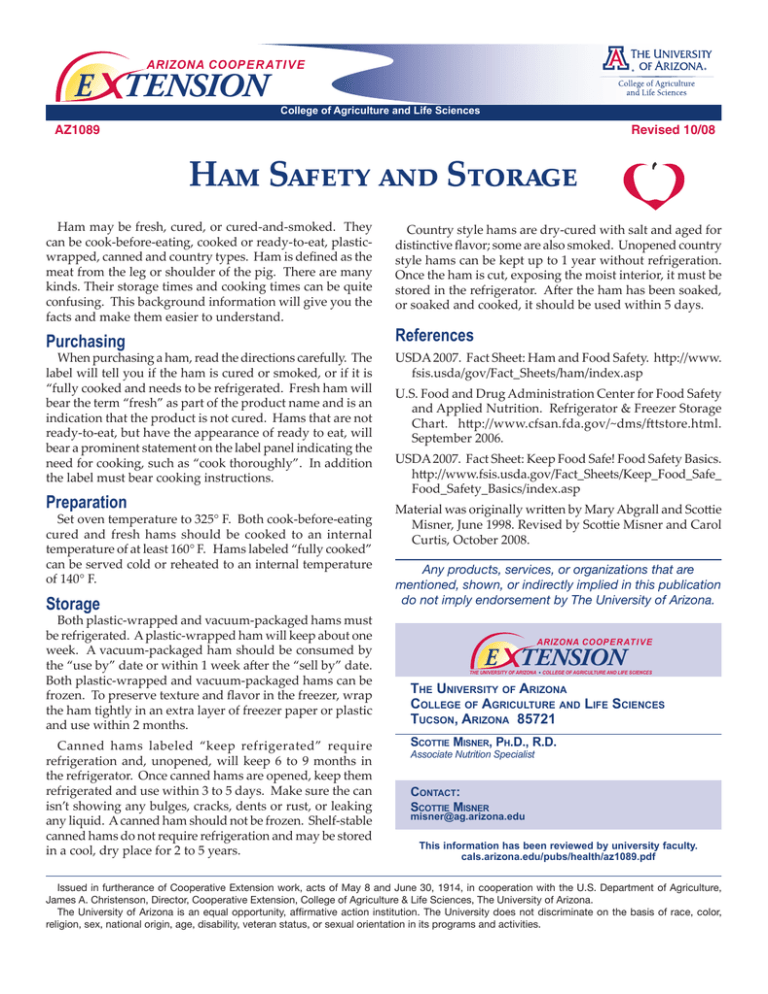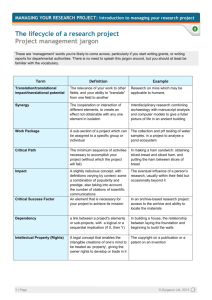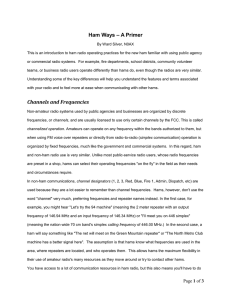Ham Safety and Storage E TENSION
advertisement

ARIZONA COOP E R AT I V E E TENSION College of Agriculture and Life Sciences AZ1089 Revised 10/08 Ham Safety and Storage Ham may be fresh, cured, or cured-and-smoked. They can be cook-before-eating, cooked or ready-to-eat, plasticwrapped, canned and country types. Ham is defined as the meat from the leg or shoulder of the pig. There are many kinds. Their storage times and cooking times can be quite confusing. This background information will give you the facts and make them easier to understand. Country style hams are dry-cured with salt and aged for distinctive flavor; some are also smoked. Unopened country style hams can be kept up to 1 year without refrigeration. Once the ham is cut, exposing the moist interior, it must be stored in the refrigerator. After the ham has been soaked, or soaked and cooked, it should be used within 5 days. Purchasing References When purchasing a ham, read the directions carefully. The label will tell you if the ham is cured or smoked, or if it is “fully cooked and needs to be refrigerated. Fresh ham will bear the term “fresh” as part of the product name and is an indication that the product is not cured. Hams that are not ready-to-eat, but have the appearance of ready to eat, will bear a prominent statement on the label panel indicating the need for cooking, such as “cook thoroughly”. In addition the label must bear cooking instructions. Preparation Set oven temperature to 325° F. Both cook-before-eating cured and fresh hams should be cooked to an internal temperature of at least 160° F. Hams labeled “fully cooked” can be served cold or reheated to an internal temperature of 140° F. Storage Both plastic-wrapped and vacuum-packaged hams must be refrigerated. A plastic-wrapped ham will keep about one week. A vacuum-packaged ham should be consumed by the “use by” date or within 1 week after the “sell by” date. Both plastic-wrapped and vacuum-packaged hams can be frozen. To preserve texture and flavor in the freezer, wrap the ham tightly in an extra layer of freezer paper or plastic and use within 2 months. Canned hams labeled “keep refrigerated” require refrigeration and, unopened, will keep 6 to 9 months in the refrigerator. Once canned hams are opened, keep them refrigerated and use within 3 to 5 days. Make sure the can isn’t showing any bulges, cracks, dents or rust, or leaking any liquid. A canned ham should not be frozen. Shelf-stable canned hams do not require refrigeration and may be stored in a cool, dry place for 2 to 5 years. USDA 2007. Fact Sheet: Ham and Food Safety. http://www. fsis.usda/gov/Fact_Sheets/ham/index.asp U.S. Food and Drug Administration Center for Food Safety and Applied Nutrition. Refrigerator & Freezer Storage Chart. http://www.cfsan.fda.gov/~dms/fttstore.html. September 2006. USDA 2007. Fact Sheet: Keep Food Safe! Food Safety Basics. http://www.fsis.usda.gov/Fact_Sheets/Keep_Food_Safe_ Food_Safety_Basics/index.asp Material was originally written by Mary Abgrall and Scottie Misner, June 1998. Revised by Scottie Misner and Carol Curtis, October 2008. Any products, services, or organizations that are mentioned, shown, or indirectly implied in this publication do not imply endorsement by The University of Arizona. ARIZONA COOP E R AT I V E E TENSION THE UNIVERSITY OF ARIZONA COLLEGE OF AGRICULTURE AND LIFE SCIENCES The University of Arizona College of Agriculture and Life Sciences Tucson, Arizona 85721 Scottie Misner, Ph.D., R.D. Associate Nutrition Specialist Contact: Scottie Misner misner@ag.arizona.edu This information has been reviewed by university faculty. cals.arizona.edu/pubs/health/az1089.pdf Issued in furtherance of Cooperative Extension work, acts of May 8 and June 30, 1914, in cooperation with the U.S. Department of Agriculture, James A. Christenson, Director, Cooperative Extension, College of Agriculture & Life Sciences, The University of Arizona. The University of Arizona is an equal opportunity, affirmative action institution. The University does not discriminate on the basis of race, color, religion, sex, national origin, age, disability, veteran status, or sexual orientation in its programs and activities.








